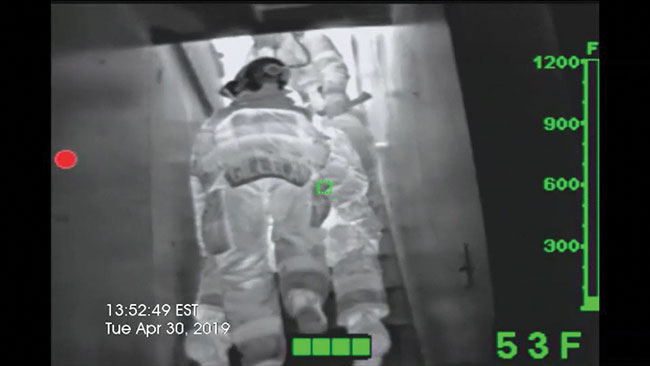
Features
Training
Thermal imaging and volunteers
Special considerations for the fire service’s largest sector
July 12, 2021
By Manfred Kihn
 A firefighter uses a TI during a RIC training evolution
Photo credit: BULLARD
A firefighter uses a TI during a RIC training evolution
Photo credit: BULLARD The volunteer sector makes up the majority of firefighterin North America. Many volunteer firefighters receive no remuneration while others receive a small stipend for the number of hours they put in. Some volunteer fire departments train once a week, some bi-weekly and some only train once a month (only 12 times a year, if the firefighters makes all 12 training sessions taking into consideration work, vacation, sickness, and family matters).
Some FDs have a dedicated training officer while others train on what the fire chief may tell them to do. A typical training night could consist of vehicle and equipment checks, which can take a while depending on how many apparatuses the FD has and how many firefighters show up for training that night, followed by an SCBA or ladder drill and a meeting. And the IFSTA Essentials of Fire Fighting manual has only gotten larger over the years, requiring volunteers to give more.
Some FDs have municipal budgets while others rely on donations and fund raisers in the community in order to keep operations going and keep purchasing equipment. I know of a FD where one time an elderly lady walked into the fire station and ask what they were in need of. They joked with her and said they could really use a TI, explained what it was and how it could help them. She asked how much they were, then pulled out her cheque book and gave them the money for one. This scenario doesn’t happen every day. But when it did, the next question was: How do we use this, what now?
Here are some helpful hints to make training easier.
1st: Have the sales rep explain to you the basic operations of the imager, turning it on/off, battery charging, changing batteries, when to replace the batteries for in the future (all batteries do not last forever) and all the different modes that the imager may have and routine maintenance. All modern TIs have basic colourization of yellow/orange/red and temperature measurement consisting of a sliding bar scale and/or digital number. Some manufactures have optional features which can get a bit confusing, so make sure you totally understand what they do.
2nd: See if the manufacture has someone that can provide proper training besides the sales rep. If they don’t, can they recommend someone and arrange to get a training class? It is all worth it in the long run to get a full understanding of the technique in using a TI, but also all the different applications and uses besides just fire fighting.
3rd: Get everyone involved in the training and make sure everyone knows and fully understands image interpretation, and how to use it safely and effectively.
4th: Include TIs in your regular FD training curriculum and use it as often as you can for all scenarios, including SCBA, ventilation, search and rescue, RIC, and size up, just to mention a few. The more you use it the more proficient you will become in using and understanding your new TI.
5th: Once you are comfortable using your TI, invite your generous source of funding down to the fire station and don’t forget the media, as you want to show off your new valued tool. Post on social media as, you never know, the coverage may net more donations for other equipment or perhaps another TI.
6th: Training is complete. The TI is mounted in an apparatus just waiting to be used. What calls are you going to use it on? All of them. It is there to make your job easier, so be sure to get it off the apparatus and use it.
7th: During Fire Prevention Week, show it off to the kids and parents show and take it with you when conducting fire inspections. You will be surprised at what you will see when looking at those electrical panels.
8th: Keep a log of all the responses where you used the TI and compare back to previous years responses to evaluate efficiency.
9th: Practice, practice, practice.
Since thermal imagers have been in use for so many years already and manufactures have made many vast improvements to their technology alongside lowered prices, there is no excuse for a FD not to have a TI.
Until next time, train often and stay safe.
Manfred Kihn is a 19-year veteran of the fire service, having served as an ambulance officer, emergency services specialist, firefighter, captain, and fire chief. He has been a member of Bullard’s Emergency Responder team since 2005 and is the company’s fire training specialist for thermal imaging technology. manfred_kihn@bullard.com
Print this page